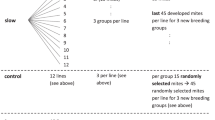Abstract
The spider mite Tetranychus urticae shows variation in its dispersal capacity (i.e., the leaf quality at which a female decides to disperse). We were able to artificially select mites that had either a high or a low dispersal capacity, indicating that this trait was genetically controlled. We then compared correlated responses to this selection. Mites with a genetically high dispersal capacity (‘HD’ strains) had a higher diapause incidence and a lower performance compared to mites with a low dispersal capacity (‘LD’ strains). A possible effect of random genetic drift during the selection was negligible. Our results suggest that differential dispersal capacity is associated with contrasting life history patterns as a result of natural selection.
Similar content being viewed by others
References
Agrawal, A.A. 2000. Host range evolution: adaptation and trade-offs in fitness of mites on alternate hosts. Ecology 81: 500-508.
Cone, W.W. 1985. Mating and chemical communication. In: Spider Mites. Their Biology, Natural Enemies and Control, W. Helle and M.W. Sabelis (eds), Vol. 1A, pp. 243-251. Elsevier, Amsterdam.
Goka, K. and Takafuji, A. 1990. Genetical studies on the diapause of the two-spotted spider mite, Tetranychus urticae Koch (1). Appl. Entomol. Zool. 25: 119-125.
Hamilton, W.D. 1967. Extraordinary sex ratios. Science 156: 477-488.
Harshman, L.G. and Hoffman, A.A. 2000. Laboratory selection experiments using Drosophila: what do they really tell us? Trends Ecol. Evol. 15: 32-36.
Jeppson, L.R., Keifer, H.H. and Baker, E.W. 1975. Mites Injurious to Economic Plants. University of California Press, Berkeley.
Kondo, A. and Takafuji, A. 1985. Resource utilization pattern of two species of tetranychid mites (Acarina: Tetranychidae). Res. Popul. Ecol. 27: 145-157.
Lees, A.D. 1953. Environmental factors controlling the evocation and termination of diapause in the fruit tree red spider mite Metatetranychus ulmi Koch (Acarina: Tetranychidae). Ann. Appl. Biol. 40: 449-486.
Li, J. and Margolies, D.C. 1993. Quantitative genetics of aerial dispersal behaviour and lifehistory traits in Tetranychus urticae. Heredity 70: 544-552.
Li, J. and Margolies, D.C. 1994. Responses to direct and indirect selection on aerial dispersal behaviour in Tetranychus urticae. Heredity 72: 10-22.
Maynard Smith, J. 1964. Group selection and kin selection. Nature 201: 1145-1147.
Nagelkerke, C.J. and Sabelis, M.W. 1996. Hierarchical levels of spatial structure and their consequences for the evolution of sex allocation in mites and other arthropods. Am. Nat. 148: 16-39.
Palmer, J.O. and Dingle, H. 1986. Direct and correlated responses to selection among lifehistory traits in milkweed bugs (Oncopeltes fasciatus). Evolution 40: 767-777.
Sabelis, M.W. 1991. Life-history evolution of spider mites. In: The Acari, R. Schuster and P.W. Murphy (eds), pp. 23-49. Chapman & Hall, London.
Southwood, T.R.E. 1977. Habitat, the templet for ecological strategies? J. Anim. Ecol. 46: 337-365.
Stearns, S.C. 1976. Life history tactics: a review of the ideas. Q. Rev. Biol. 51: 3-47.
Takafuji, A., So, P.-M. and Tsuno, N. 1991. Inter-and Intra-population variations in diapause attribute of the two-spotted spider mite, Tetranychus urticae Koch, in Japan. Res. Popul. Ecol. 33: 331-344.
Veerman, A. 1977. Aspects of the induction of diapause in a laboratory strain of the mite Tetranychus urticae. J. Insect Physiol. 23: 703-711.
Wrensch, D.L. and Ebbert, M.A. (eds) 1993. Evolution and Diversity of Sex Ratio in Insects and Mites. Chapman & Hall, New York.
Yano, S., Wakabayashi, M., Takabayashi, J. and Takafuji, A. 1998. Factors determining the host plant range of the phytophagous mite, Tetranychus urtucae (Acari: Tetranychidae): a method for quantifying host plant acceptance. Exp. Appl. Acarol. 22: 595-601.
Yano, S., Takabayashi, J. and Takafuji, A. 2001. Trade-offs in performance on different plants may not restrict the host plant range of the phytophagous mite, Tetranychus urticae. Exp. Appl. Acarol. 25: 371-381.
Author information
Authors and Affiliations
Corresponding author
Rights and permissions
About this article
Cite this article
Yano, S., Takafuji, A. Variation in the Life History Pattern of Tetranychus Urticae (Acari: Tetranychidae) after Selection for Dispersal. Exp Appl Acarol 27, 1–10 (2002). https://doi.org/10.1023/A:1021518221031
Issue Date:
DOI: https://doi.org/10.1023/A:1021518221031




